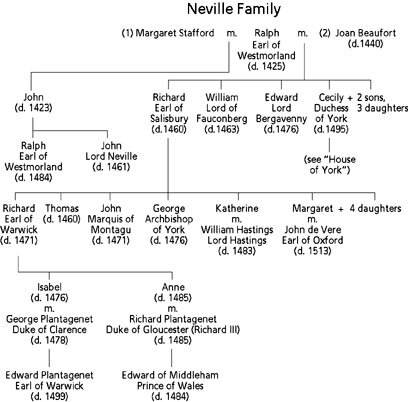Richard, Duke of York (1411–1460)
The son of Richard, earl of Cambridge (c. 1375–1415), and Anne Mortimer (1390–1411), York was descended from Edward III through both parents. Although his paternal grandfather, Edmund, duke of York (1341–1402), was Edward’s fourth son, York’s claim to the Crown rested on his descent from his maternal great-great grandfather, Lionel, duke of Clarence (1338–1368), Edward’s second son. Despite deriving from the maternal line, York’s claim through Clarence rivaled that of his kinsman, Henry VI, because the king was a great-grandson of Edward III’s third son, John, duke of Lancaster (1340–1399).

In 1425, upon the death of his uncle, Edmund Mortimer, earl of March, York inherited both the Mortimer claim to the throne and the family’s vast estates, which, with his paternal inheritance, made York the wealthiest member of the English Peerage. Knighted by Henry VI in 1426, York accompanied the king to France in 1430. In 1429, York married Cecily Neville, daughter of Ralph Neville, earl of Westmorland (c. 1364–1425). Appointed king’s lieutenant in France in 1436, and reappointed in 1440, York was given generous French land grants. In 1445, the government recalled York, who became heir apparent to the childless Henry VI in 1447. Although he held extensive estates in Wales and Ireland, York considered his 1447 appointment as king’s lieutenant in Ireland to be banishment and did not travel to Dublin until 1449.
Angered by the government’s failure to repay debts incurred while in the royal service abroad, as well as by what he viewed as his exclusion from the political position that was due him by birth, York returned to England in 1450, only months after dissatisfaction with Henry VI’s government led to the outbreak of Jack Cade’s Rebellion. Suspected by the court of fomenting the uprising, York quarreled with Edmund Beaufort, duke of Somerset, whom York (and others) held responsible for the recent loss of Normandy. However, Somerset remained in high favor at court, and York, fearing that the duke was endeavoring to destroy him, took up arms in 1452 to compel the king to arrest Somerset. Although Henry initially agreed to York’s demands, the duke’s uprising collapsed at Dartford when few nobles supported him, and the king reneged on his promise to abandon Somerset. Although forced only to swear loyalty to Henry, York was politically isolated and excluded from government.
This situation was transformed in 1453 by the onset of the king’s mental illness and by the birth of the king’s son, Prince Edward of Lancaster. The first event led to Somerset’s arrest and York’s appointment as protector of the realm in March 1454, and the second made an implacable opponent of Queen Margaret of Anjou, who was concerned for her son’s future and suspicious of York’s ambition. In February 1455, Henry’s recovery ended York’s First protectorate. However, the king, now increasingly under the queen’s influence, restored Somerset to favor, and the renewed quarrel between the two dukes soon absorbed various local feuds, including the Neville-Percy feud in northern England. As Henry Percy, earl of Northumberland, drew closer to the court, York formed an alliance with the earl’s rivals, Richard Neville, earl of Salisbury, who was the duke’s brother-in-law, and Salisbury’s son, Richard Neville, earl of Warwick. Backed by the extensive political and military resources of the Neville family, York again sought to force the king to abandon Somerset. At the Battle of St. Albans in May 1455, York and the Nevilles slew Somerset and Northumberland and took control of Henry and the royal government.
In November, after Henry suffered a relapse, Parliament reappointed York as protector, but the Second protectorate ended with the king’s recovery in February 1456. An attempt in 1458 to reconcile York and the Nevilles with the Queen and the heirs of the nobles who had been slain at St. Albans, factions formed around both parties after 1456, and civil war erupted in 1459. After the Battle of Ludford Bridge in October, York fled to Ireland, where he was popular, and the Nevilles withdrew to Calais, where Warwick was captain. In June 1460, the Nevilles, accompanied by York’s son, Edward, returned to London; in July, Warwick captured the King at the Battle of Northampton, thereby allowing York to return from Ireland in September. On 16 October, the duke made formal claim to the Crown by right of inheritance, but Parliament received the petition with little enthusiasm. By the end of the month, Parliament, with the acquiescence of both the King and the duke, passed the Act of Accord, a settlement that left Henry on the throne but disinherited Prince Edward in favor of York and his heirs.
Immediately rejected by the queen and her supporters, the Act of Accord drove Lancastrians across England to rise against the Yorkist regime. With northern England in rebellion, York and Salisbury marched out of London in early December. After some difficulty, the duke reached Sandal castle in late December and on 30 December, York left Sandal to attack the Lancastrian forces converging on the castle. Commanded by Henry Beaufort, duke of Somerset, John Clifford, Lord Clifford, and other sons of nobles slain at St. Albans, the Lancastrian army surrounded and killed the duke at the Battle of Wakefield. York’s death passed his claim to the throne to his son, who, within weeks, was proclaimed King as Edward IV. After Wakefield, the victorious Lancastrians adorned York’s head with a paper crown and set it, along with those of Salisbury and the duke’s son, Edmund Plantagenet, earl of Rutland, on the gates of York.
